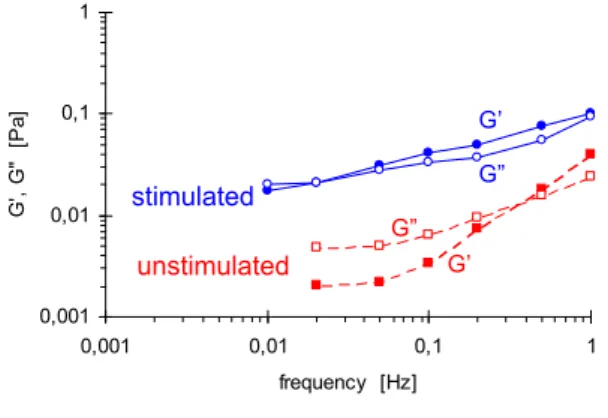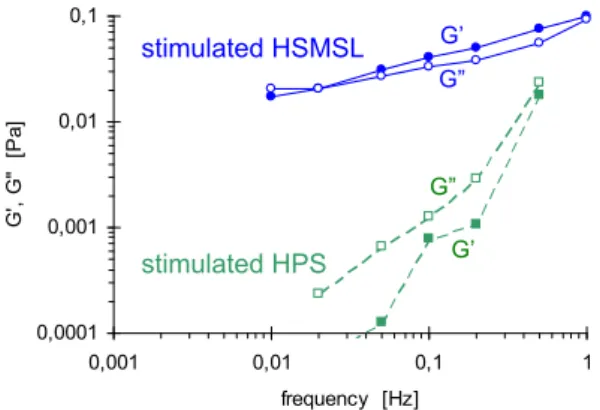ANNUAL TRANSACTIONS OF THE NORDIC RHEOLOGY SOCIETY, VOL. 17, 2009
.
hs/η vs. hs
Viscoelastic properties of saliva from different glands
Mats Stading1, 2, Daniel Johansson1, Christina Diogo-Löfgren3 and Cecilia Christersson3 1 SIK – The Swedish Institute for Food and Biotechnology, Göteborg, Sweden
2 Chalmers University of Technology, Göteborg Sweden 3 Malmö University, Faculty of Odontology, Malmö, Sweden
ABSTRACT
The viscoelastic properties of saliva from different glands were characterized using small amplitude oscillatory shear with a narrow gap parallel plate system. Mechanical spectra of stimulated and unstimulated human submandibular-sublingual saliva (HSMSL) and human parotid saliva (HPS) were compared. The HSMSL saliva had higher modulus and longer relaxation times due to higher mucus content than the parotid saliva. Unstimulated saliva showed the same behaviour when compared to stimulated saliva, but only after a resting period of 20 minutes.
INTRODUCTION
The major functions of saliva are to protect hard and soft oral tissues from wear, dehydration, demineralisation, chemical insult and microbial imbalance1. It is particular salivary glycoproteins such as mucins and proline-rich proteins that have structural features that correlate to the protective function of masticatory lubrication. Mucins, of both high-molecular weight (MUC5B) and low-molecular weight (MUC7), are secreted from the submandibular-sublingual salivary glands while the proline-rich glycoproteins emanate from the parotid glands.
Saliva is a dilute viscoelastic polymer solution with very low shear modulus and is therefore difficult to characterize
experi-mentally. The saliva is present only in small volumes thus further limiting the experi-mental techniques available. Davies and Stokes have developed an experimental technique which combines small sample volumes with high strains and strain rates and demonstrated its applicability for saliva viscoelasticity.2. The method utilizes a parallel plate system with narrow gaps down to 5 μm. The advantages of this new tech-nique as compared to previous measure-ments using oscillating capillary flow3 and
resonant oscillation4,5 are a wide selection
of frequencies and a well defined strain THEORY
Small amplitude oscillatory shear with a narrow gap parallel plate system was used to be able to measure the viscoelastic properties of such a dilute system as saliva. The technique has been thoroughly described by Davies and Stokes6 and utilizes the high strains and strain rates produced in narrow gaps. In order to obtain meaningful measurements numerous gap errors have to be accounted for. The most prominent error is the unavoidable misalignment of the parallel plates which produces an underestimation in the measurements at gaps less than a few tenths of a millimetre. A typical gap error is 5-30 μm. The gap error Δh is determined by measuring the viscosity ηm of a Newtonian
liquid for decreasing set gap heights hs. A
true s true m s h h h η η η Δ + = 1 (1)
will give a straight line with slope 1/ηtrue
and an intercept of Δh/ηtrue where ηtrue is the
true viscosity of the Newtonian fluid. The gap error can then be used to give a corrected modulus through
s s measured true h h h G G = +Δ (2)
where G refers to either G’ or G”. MATERIALS AND METHODS
Unstimulated saliva as well as stimulated saliva from the submandibular-sublingual glands and the right side parotid gland of two healthy female individuals was collected. A custom made collector for the SMSL saliva was individually adapted to the floor of the mouth of each of the donors by silicone impression material (Provil®). A Lashley cup was utilised to collect saliva from the parotid gland. Unstimulated saliva was passively collected by allowing the donor to undisturbed drool into a test tube. Gustatory stimulation was achieved by applying 2 % citric acid on the sides of the tongue with a cotton swab every 30 second until the test volume was collected.
A Stresstech HR rheometer (Reologica Instruments, Lund Sweden) equipped with a parallel plate measuring system (30 mm diameter plates) was used. The gap error was first determined to be Δh=3.9μm using a Newtonian calibration oil with a viscosity of 1.09 mPas at 20°C.
100 μl of the saliva was pipetted to the centre of the bottom plate.. The upper plate was lowered to a gap of 50 μm and a measurement was started immediately (t=0) or after a resting period of t=20 minutes. A mechanical spectrum was recorded in the interval 0.001-1 Hz. The parallel plate
system was covered with a solvent-trap enclosure ensuring high relative humidity surrounding the sample to avoid drying of the sample. The mechanical spectra were recorded in the linear region using an applied stress of 0.02 Pa. All measurements were performed at 20°C.
RESULTS AND DISCUSSION
The effect on saliva viscoelastic properties by stimulated production was studied at t=0 (Fig. 1) and at t=20 min (Fig. 2). The stimulated saliva was expected to have lower moduli due to the stimulation causing a more dilute saliva. At time t=0 stimulated and unstimulated saliva had similar moduli with the stimulated saliva even displaying slightly higher G’ and G”, see Fig. 1. Both unstimulated and stimulated saliva was highly elastic with G’≈G” which is in line with previous results.
0,001 0,01 0,1 1 0,001 0,01 0,1 1 frequency [Hz] G ', G " [P a] G’ G” stimulated G” unstimulated G’
Figure 1. Mechanical spectra of stimulated (blue, solid lines) and unstimulated (red,
dashed lines) submandibular-sublingual saliva at t=0 (freshly expectorated). G’ in
filled symbols and G” in open symbols. After 20 minutes at rest both unstimulated and stimulated saliva showed an increased elasticity with G’>G” for the whole frequency range measured. The G’-G” crossover occurred at lower frequency indicating longer relaxation times of the saliva after 20 minutes of resting. These results demonstrate the formation of an entanglement structure in the saliva over time. The unstimulated HSMSL saliva, with the supposed higher mucus content gained
more elasticity and displayed clearly higher G’ and G” than the unstimulated saliva after the resting period, as shown in Fig. 2.
0,001 0,01 0,1 1 0,0001 0,001 0,01 0,1 1 frequency [Hz] G' , G" [ P a]
Figure 2. Mechanical spectra of stimulated (blue, solid lines) and unstimulated (red,
dashed lines) submandibular-sublingual saliva after 20 minutes. G’ in filled symbols
and G” in open symbols.
0,0001 0,001 0,01 0,1 0,001 0,01 0,1 1 frequency [Hz] G ', G " [P a]
Figure 3. Mechanical spectra of stimulated submandibular-sublingual saliva (blue, solid
lines) and stimulated parotid saliva (green, dashed lines) t=0 (freshly spitted). G’ in filled symbols and G” in open symbols. The saliva produced by the submandibular-sublingual glands differs in composition and physiological functions from the saliva produced by the parotid glands. This is clearly reflected by the mechanical spectra of the two as shown in Fig. 3. The parotid glands have no production of mucins. The constant applied stress to the parotid saliva
produced strains outside the linear region at the lower frequencies.
CONCLUSIONS
The characterization of viscoelastic properties of human saliva by small amplitude oscillatory shear with a narrow gap parallel plate system showed that
G’ unstimulated
G” G’
G”
stimulated • saliva from the
submandibular-sublingual glands forms an entanglement structure over time scales at the order of 20 minutes. • the submandibular-sublingual glands
produces significantly more viscoelastic saliva than the parotid gland.
• mechanical spectra with G’ and G” in the order of 10-2 Pa of dilute
polymer solutions such as saliva can reproducibly be determined using a gap of 50 μm.
• in order to measure even lower moduli smaller gaps and larger plates must be utilized.
G’ stimulated HSMSL G” G” REFERENCES G’ stimulated HPS
1 Schipper,R.G., Silletti, E. and
Vingerhoeds, M.H. (2007) “Saliva as research material: Biochemical, physico-chemical and practical aspects”, Arch. Oral
Biol., 52, 1114-1135.
2 Davies, G.A. and Stokes, J.R. (2007)
“Viscoelasticity of human whole saliva collected after acid and mechanical stimulation”, Biorheology, 44, 141-160
3 van der Reijden, W.A., Veerman, E.C.I.
and van Nieuw Amerongen, A. (1993) “Shear rate dependent viscoelastic behaviour of human glandular salivas”,
Biorheology, 30, 141-152.
4 Christersson, C.E., Lindh, L. and
Arnebrandt, T. (2000) “Film forming properties and viscosities of saliva substitutes and human whole saliva”, Eur. J.
5 van der Reijden, W.A., Veerman, E.C.I. and van
Nieuw Amerongen, A. (1994) “Rheological pro-perties of commercially available polysaccharides with potential use in saliva substitutes”, Biorheology,
31, 631-642.
6 Davies, G.A. and Stokes, J.R. (2008) “Thin film
and high shear rheology of multiphase complex fluids”, J. Non-Newtonian Fluid Mech., 148, 73–87.

